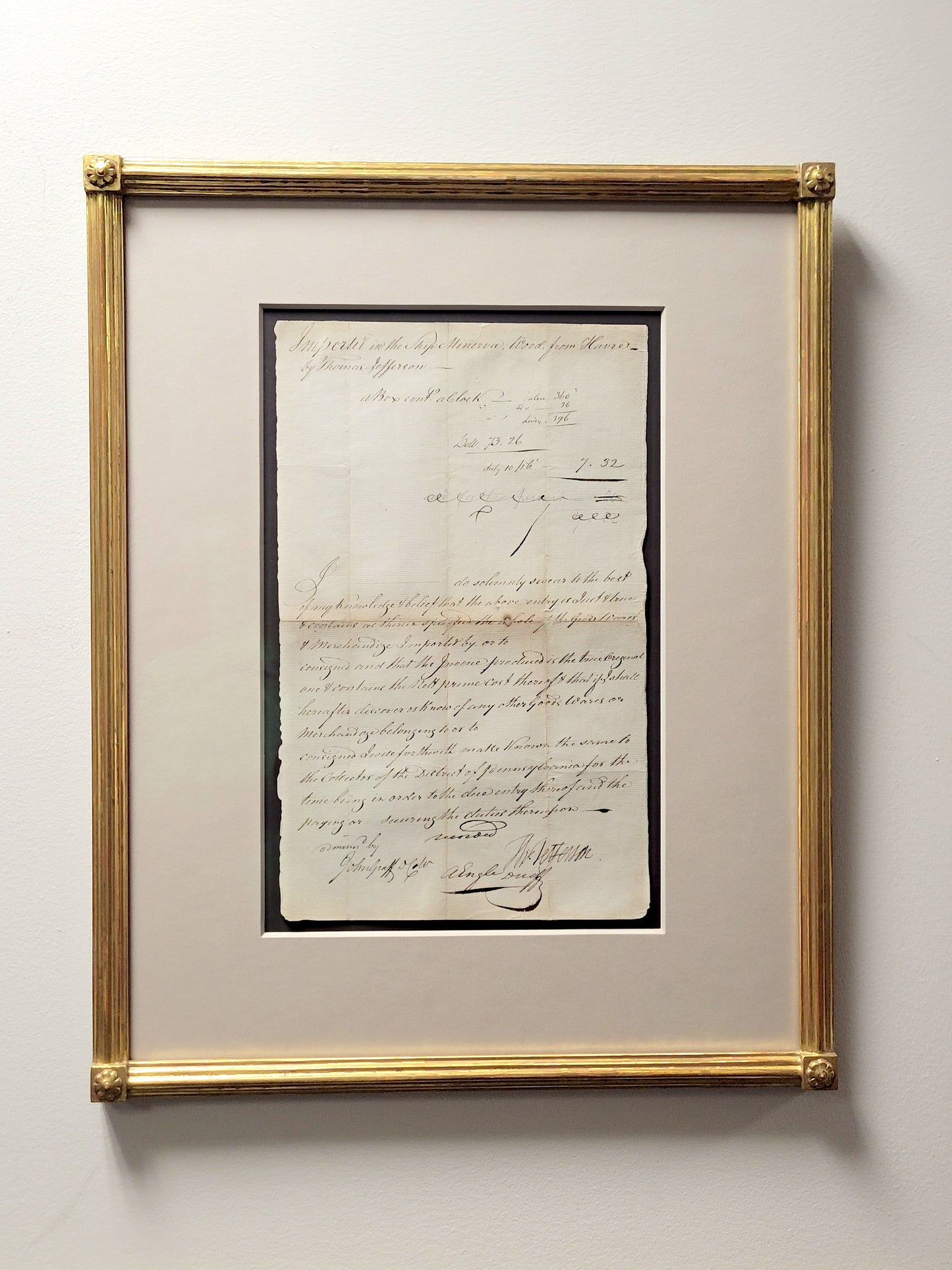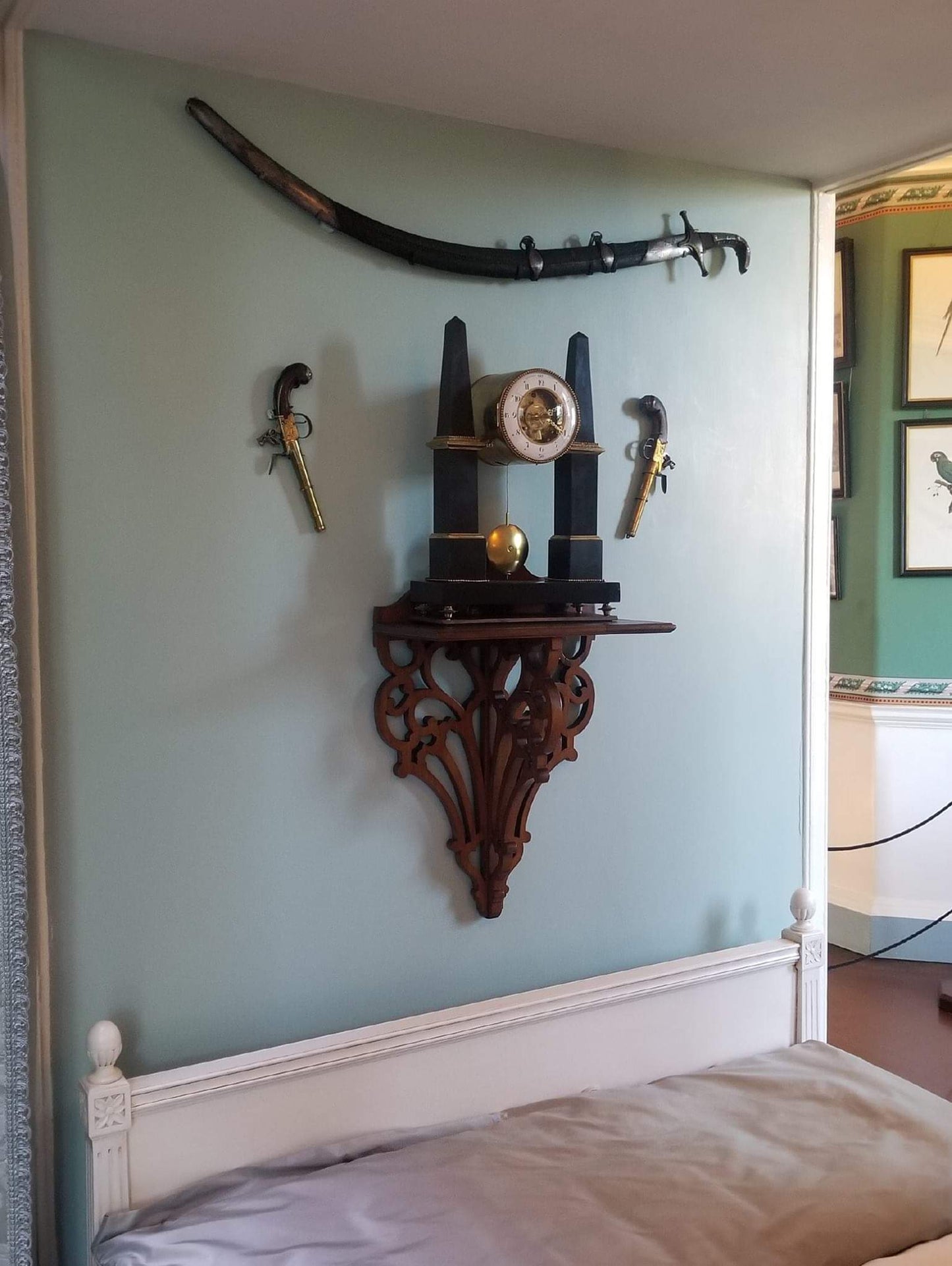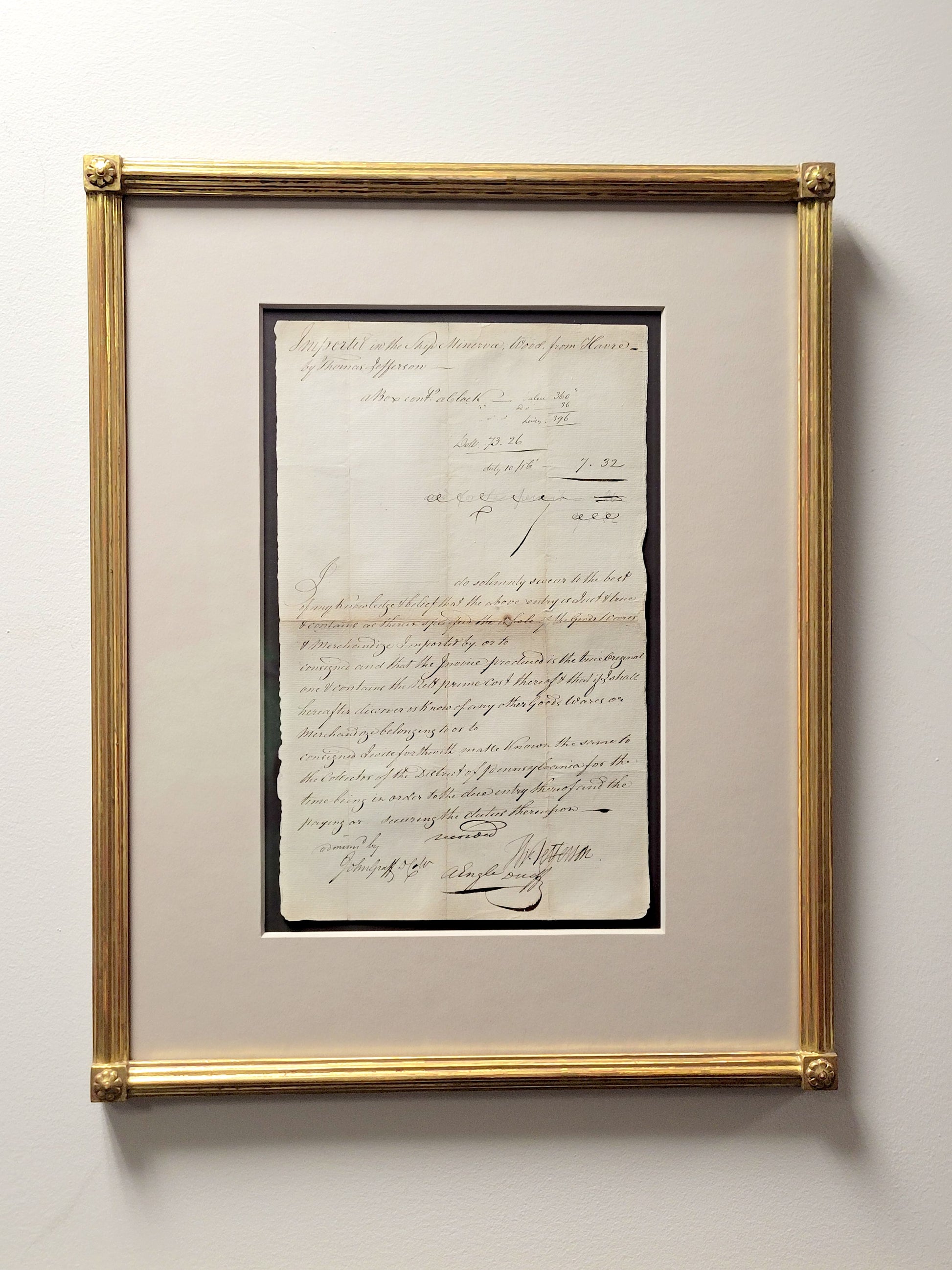The History List
Document signed by Thomas Jefferson for the import duty on his famous Louis Chantrot Obelisk Clock
$13,900
Couldn't load pickup availability
Price: $13,900
Payment process: $500 paid now and the rest wired within three business days.
We will supply the buyer with wire instructions. If the sending institution charges a fee for sending the wire, that amount should be added to the total to be sent so that it nets to $13,400. If payment isn’t completed, we’ll return the $500 and contact the next person who wanted to buy it.
We're using this process in order to reduce unnecessary platform fees and to give the buyer the ability to wire payment instead of having to charge their credit card.
If you are considering buying this and have questions: Please feel free to contact me.
About this document, signed by Thomas Jefferson
This is a rare record of payment of the tariffs that funded the nascent federal government, in effect bringing together Secretary of the Treasury Alexander Hamilton and Secretary of State Thomas Jefferson in the temporary capital of Philadelphia.
This document shows that Thomas Jefferson imported the clock, which arrived in Philadelphia on the ship Minerva from La Havre, France, on October 17, 1791. On May 12, 1792, Jefferson paid the import duty of $7.52 according to the provisions of the Tariff of 1790.
Jefferson’s earlier correspondence to William Short arranging for the purchase and delivery of the clock also mentioned obtaining two artists proofs for the Congressional Medal of Honor voted for John Paul Jones. See more under Historical background below.
About the clock
Jefferson designed the clock, which consists of a pair of black marble obelisks between which a brass clock was suspended, and in the Spring of 1790 commissioned the leading French clockmaker, Louis Chantrot, to build it.
As shown in the photo, at Monticello he had it mounted on a shelf above the foot of his bed. It replaced a similar piece stolen from his Paris residence.
Susan Stein, the Richard Gilder Senior Curator at Monticello, described the obelisk clock as “arguably one of the most important and interesting objects at Monticello.” (View the video here.) After Jefferson’s death, his daughter Martha called it the object “I should have prized beyond anything on earth.” The original clock was passed down through the Jefferson family until it was donated to Monticello in 2016.
About the document condition
The document is framed as shown and done in an archival manner to protect the document.
Complete transcript
Imported in the Ship Minerva, Wood, from Havre, by Thomas Jefferson / a Box, contg a Clock value 360 / adv 36 / Lev’ry 396 / Doll. 73.26 / Duty 10 prC’ – 7.32
add for the permit 20 7.52
I do solemnly swear to the best of my knowledge & belief that the above entry is Just & true & contains as therein specified the whole of the Goods Wares & Merchandize Imported by, or to consigned and that the Invoice produced is the true Original one & contains the net prime cost thereof & that if I shall hereafter discover or Know of any other Goods Wares or Merchandize belonging to or to consigned I will forthwith make known the same to the Collector of the District of Pennsylvania for the time being in order to the due entry thereof and the paying or securing the duties thereupon. / recorded
[signed]Th: Jefferson
adminisd by / John Graff D C W / A Engle Duoff
[Docketing on verso:] 17th Octor 1791 / Ship Minerva / Wood / Thos Jefferson / Pd May 12, 1792
Historical background
On July 4, 1789, the first major act passed by the First Federal Congress was “An act for laying a duty on Goods, wares, and Merchandizes, imported into the United States… for the support of government, for the discharge of the debts of the United States, and the encouragement and protection of manufactures.” Revenues from the Tariff of 1789 were insufficient to meet the government’s obligations, so on August 10, 1790 Congress passed “An Act making further provisions for the payment of the debts of the United States,” revising the rates and adding specific luxury items, including “clocks and watches,” subject to a 10 percent ad valorem duty.
Secretary of the Treasury Alexander Hamilton allowed Jefferson’s furniture and household items shipped from Paris to enter the country without paying any duties, but this clock, newly manufactured in Paris, was not part of Jefferson’s furnishings there. The 10-percent duty was $7.32. Although the line “add for the permit .20” is crossed out, Jefferson wrote in his 1792 account book that he paid $7.52 on May 12 for “duty on clock importd. last year.”
This declaration is also signed by John Graff, the weigher and later deputy collector in the customs office at Philadelphia, and Archibald Engle, a deputy collector of revenue for the district of Pennsylvania in Philadelphia.
Thomas Jefferson had a special interest in timepieces. He purchased a clock in France by correspondence approximately six months before leaving for Paris, and at least three more while in Paris from 1784 to 1789. Virtually every room of Monticello contained at least one clock.
After he returned to the United States, Jefferson wrote in April 1790 to William Short, his private secretary when Jefferson was a peace commissioner in France, asking Short to obtain and arrange packing and shipping of several items, including books and pieces of furniture.
Jefferson also enclosed a sketch (shown below, and not included in the document for sale) that described in detail a “little clock which was stolen from the chimney of my study. The parts a.b. c.d. were parts of a cone, being round and tapering to the top, where a gilt head was put on. I would wish one to be made like that, as to the pedestal part, but with obelisks as is represented here a.b. c.d. instead of conical columns as the former had. No gilt head to be on the obelisk, but to be in plain marble, cut off obliquely as is always done in the obelisk. The section of an obelisk, you know, is a square; I mean it’s ichnography [horizontal section, usually a ground plan of a building, to scale].

“The clock to have a pendulum vibrating half seconds exactly. To have a second hand, but none for the days of the week, month or moon. To strike the hours and half hours. The dial plate to be open work, or as the French workmen say, le cadran à jour, of black marble. The superintendant of the Salle des ventes (where I bought mine) undertook to have a clock on the above plan made for me, for either 12. or 15. guineas, I forget which. He required only 3. or 4. weeks. I shall be obliged to Mr. Short to have one made immediately for me, that it may be done in time to come with my other things.”
On June 14, Short informed Jefferson, “The Directeur de la salle des ventes, has the model of the clock, with a verbal and written explanation which I gave him. He began by asking twenty guineas for it, and says it will require four weeks to have it made. As he found I would not give him the price he asked he is to let me know in a day or two if he will undertake it for fifteen. If not I shall endeavour to get it made elsewhere." Nearly two months later, on August 4, Short wrote, “All your commissions have been executed, except that of the clock. The workman after promising faithfully it should be finished for the 15th. of July, had not at that term even begun it. I am at a loss whether to have it made at present, as I know not whether you would wish to have it sent alone.” He asked for further instructions from Jefferson.
On January 24, 1791, Jefferson wrote to Short from Philadelphia, “I must pray you to keep in mind and execute the commissions for the clock (which must come entirely by water from Paris to this place) and two epreuves d’etains of P. Jones’s [artist’s proofs of John Paul Jones’] medal.” Three months later, on April 26, Short wrote to Jefferson that the clock would be ready “in three weeks and immediately sent to Havre.” The price Chanterot asked was the same as that for “the salle des ventes (15. guineas).” On May 2, Short again wrote to Jefferson, “You will recieve by Petit your reveille watch mended by Chanterot who assures me it is now in perfect order. He is making the clock for 15. louis. He assures me also with respect to it that he does not gain a sol and that it is altogether for the honor and pleasure of serving you. It will be sent as soon as finished, by water to Havre.”
The clock was still not ready by July 17, when Short wrote in frustration, “The clock which I am now promised daily and the mending your reveille watch will be to be paid out of this balance and I shall accordingly draw on it for that purpose when Chanterot shall be ready.” The ship Minerva, under the command of Captain Wood, left Havre de Grace, France, in late July or early August, with a stop in Amsterdam, before sailing on to Philadelphia, where it arrived in mid-October with Jefferson’s clock.
Sources: Seth Kaller for the historical background. Monticello for the photos of the clock at Monticello. Excerpt of the letter with the instructions is courtesy of William & Mary via Monticello's curatorial staff's Facebook page.
Mission
Mission
Your purchases support our mission to engage people with local history and to support historic sites and history organizations across the country.




